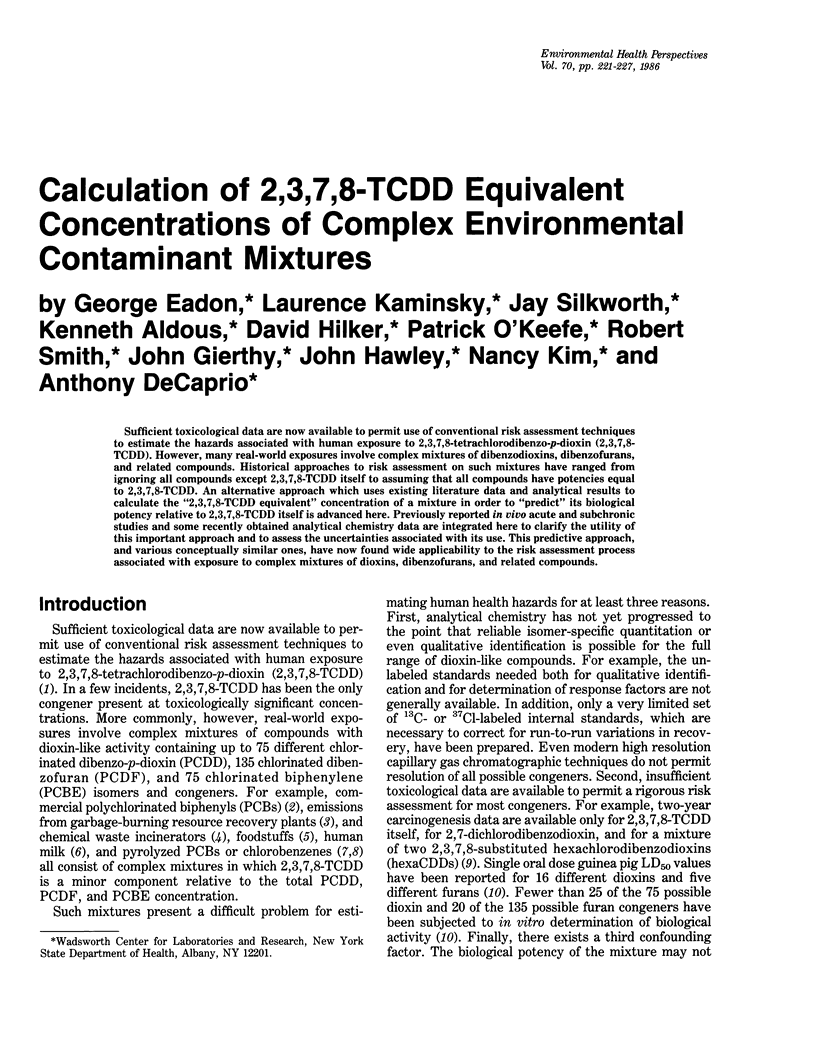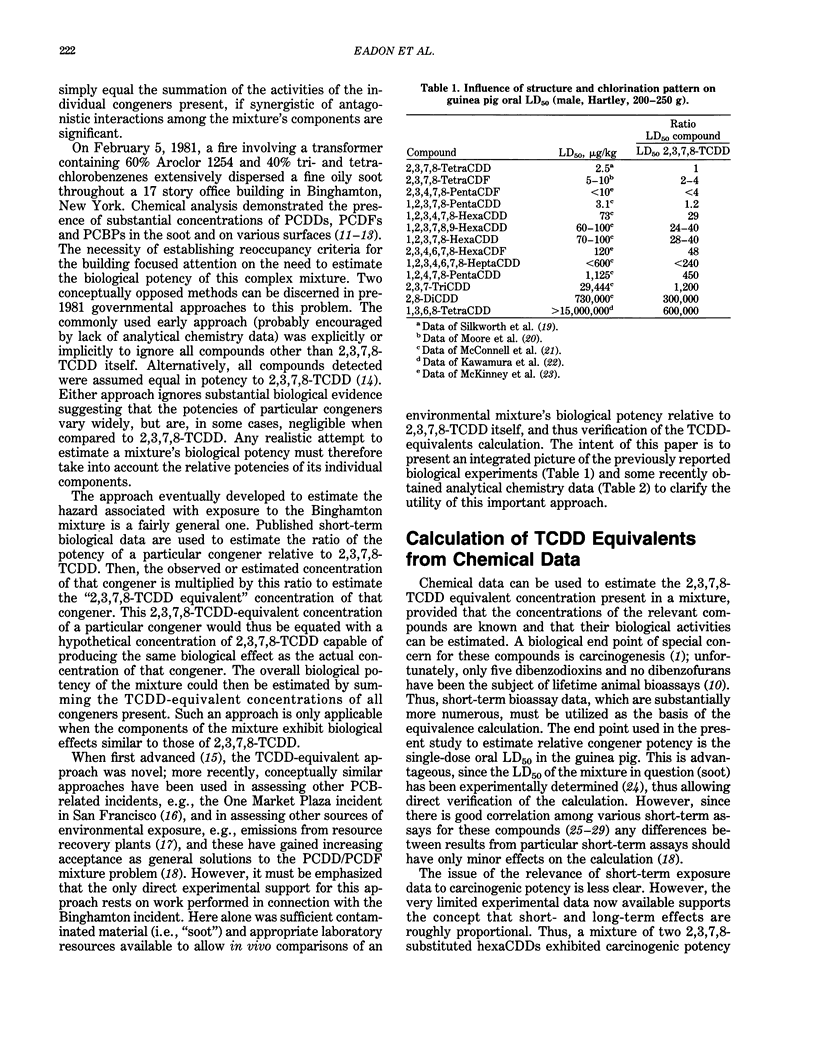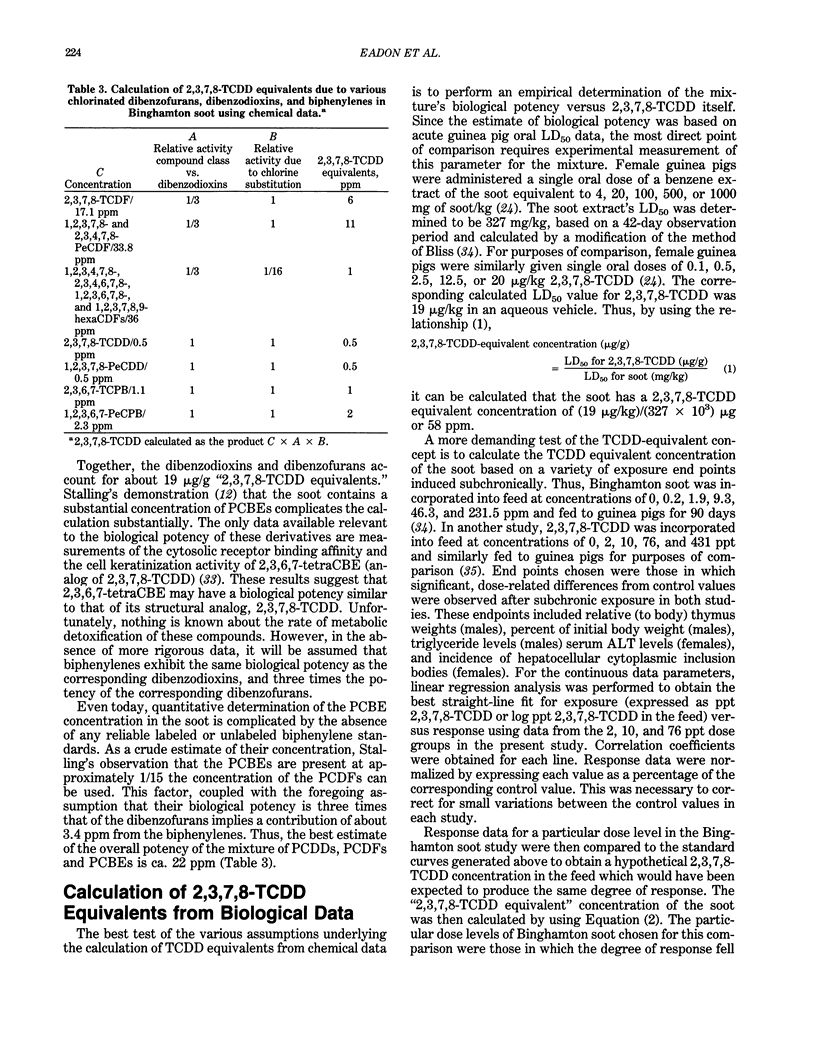Abstract
Sufficient toxicological data are now available to permit use of conventional risk assessment techniques to estimate the hazards associated with human exposure to 2,3,7,8-tetrachlorodibenzo-p-dioxin (2,3,7,8-TCDD). However, many real-world exposures involve complex mixtures of dibenzodioxins, dibenzofurans, and related compounds. Historical approaches to risk assessment on such mixtures have ranged from ignoring all compounds except 2,3,7,8-TCDD itself to assuming that all compounds have potencies equal to 2,3,7,8-TCDD. An alternative approach which uses existing literature data and analytical results to calculate the “2,3,7,8-TCDD equivalent” concentration of a mixture in order to “predict” its biological potency relative to 2,3,7,8-TCDD itself is advanced here. Previously reported in vivo acute and subchronic studies and some recently obtained analytical chemistry data are integrated here to clarify the utility of this important approach and to assess the uncertainties associated with its use. This predictive approach, and various conceptually similar ones, have now found wide applicability to the risk assessment process associated with exposure to complex mixtures of dioxins, dibenzofurans, and related compounds.
Full text
PDF






Selected References
These references are in PubMed. This may not be the complete list of references from this article.
- Bandiera S., Sawyer T., Romkes M., Zmudzka B., Safe L., Mason G., Keys B., Safe S. Polychlorinated dibenzofurans (PCDFs): effects of structure on binding to the 2,3,7,8-TCDD cytosolic receptor protein, AHH induction and toxicity. Toxicology. 1984 Aug;32(2):131–144. doi: 10.1016/0300-483x(84)90132-x. [DOI] [PubMed] [Google Scholar]
- Bradlaw J. A., Casterline J. L., Jr Induction of enzyme activity in cell culture: a rapid screen for detection of planar polychlorinated organic compounds. J Assoc Off Anal Chem. 1979 Jul;62(4):904–916. [PubMed] [Google Scholar]
- Bumb R. R., Crummett W. B., Cutie S. S., Gledhill J. R., Hummel R. H., Kagel R. O., Lamparski L. L., Luoma E. V., Miller D. L., Nestrick T. J. Trace chemistries of fire: a source of chlorinated dioxins. Science. 1980 Oct;210(4468):385–390. doi: 10.1126/science.6159682. [DOI] [PubMed] [Google Scholar]
- Carmines E. L., Carchman R. A., Borzelleca J. F. A method for the evaluation of dose-effect data utilizing a programmable calculator. J Environ Pathol Toxicol. 1980 Aug;4(1):23–30. [PubMed] [Google Scholar]
- DeCaprio A. P., McMartin D. N., O'Keefe P. W., Rej R., Silkworth J. B., Kaminsky L. S. Subchronic oral toxicity of 2,3,7,8-tetrachlorodibenzo-p-dioxin in the guinea pig: comparisons with a PCB-containing transformer fluid pyrolysate. Fundam Appl Toxicol. 1986 Apr;6(3):454–463. doi: 10.1016/0272-0590(86)90219-8. [DOI] [PubMed] [Google Scholar]
- DeCaprio A. P., McMartin D. N., Silkworth J. B., Rej R., Pause R., Kaminsky L. S. Subchronic oral toxicity in guinea pigs of soot from a polychlorinated biphenyl-containing transformer fire. Toxicol Appl Pharmacol. 1983 Apr;68(2):308–322. doi: 10.1016/0041-008x(83)90015-7. [DOI] [PubMed] [Google Scholar]
- Kimbrough R. D., Falk H., Stehr P., Fries G. Health implications of 2,3,7,8-tetrachlorodibenzodioxin (TCDD) contamination of residential soil. J Toxicol Environ Health. 1984;14(1):47–93. doi: 10.1080/15287398409530562. [DOI] [PubMed] [Google Scholar]
- Knutson J. C., Poland A. Keratinization of mouse teratoma cell line XB produced by 2,3,7,8-tetrachlorodibenzo-p-dioxin: an in vitro model of toxicity. Cell. 1980 Nov;22(1 Pt 1):27–36. doi: 10.1016/0092-8674(80)90151-8. [DOI] [PubMed] [Google Scholar]
- Mason G., Sawyer T., Keys B., Bandiera S., Romkes M., Piskorska-Pliszczynska J., Zmudzka B., Safe S. Polychlorinated dibenzofurans (PCDFs): correlation between in vivo and in vitro structure-activity relationships. Toxicology. 1985 Oct;37(1-2):1–12. doi: 10.1016/0300-483x(85)90108-8. [DOI] [PubMed] [Google Scholar]
- McConnell E. E., Moore J. A., Haseman J. K., Harris M. W. The comparative toxicity of chlorinated dibenzo-p-dioxins in mice and guinea pigs. Toxicol Appl Pharmacol. 1978 May;44(2):335–356. doi: 10.1016/0041-008x(78)90195-3. [DOI] [PubMed] [Google Scholar]
- O'Keefe P. W., Silkworth J. B., Gierthy J. F., Smith R. M., DeCaprio A. P., Turner J. N., Eadon G., Hilker D. R., Aldous K. M., Kaminsky L. S. Chemical and biological investigations of a transformer accident at Binghamton, NY. Environ Health Perspect. 1985 May;60:201–209. doi: 10.1289/ehp.8560201. [DOI] [PMC free article] [PubMed] [Google Scholar]
- Poland A., Greenlee W. F., Kende A. S. Studies on the mechanism of action of the chlorinated dibenzo-p-dioxins and related compounds. Ann N Y Acad Sci. 1979 May 31;320:214–230. doi: 10.1111/j.1749-6632.1979.tb56603.x. [DOI] [PubMed] [Google Scholar]
- Poland A., Knutson J. C. 2,3,7,8-tetrachlorodibenzo-p-dioxin and related halogenated aromatic hydrocarbons: examination of the mechanism of toxicity. Annu Rev Pharmacol Toxicol. 1982;22:517–554. doi: 10.1146/annurev.pa.22.040182.002505. [DOI] [PubMed] [Google Scholar]
- Silkworth J., McMartin D., DeCaprio A., Rej R., O'Keefe P., Kaminsky L. Acute toxicity in guinea pigs and rabbits of soot from a polychlorinated biphenyl-containing transformer fire. Toxicol Appl Pharmacol. 1982 Sep 30;65(3):425–439. doi: 10.1016/0041-008x(82)90388-x. [DOI] [PubMed] [Google Scholar]


